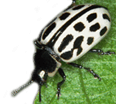Etymology of the scientific species names of the beetle fauna of Germany |
|
The etymology module allows to "translate" many scientific species names of the beetles from the German fauna. Often, their names are derived from Latin or ancient Greek words which describe the beetle and its properties. Those interested to learn what Harpalus rufipes actually means, have found the right place on kerbtier.de. The basis of this module is the publication "Erklärung der wissenschaftlichen Käfernamen aus Reitters Fauna Germanica" by Sigmund Schenkling, published in 1917 at K.G. Lutz in Stuttgart. I have added some editorial amendments and translated the entire work into English. |
|
| Term | Meaning |
|---|---|
| albovittatus, a, um, albovittis (albovittātus, a, um, albovíttis) | with white longitudinal bands |
| bivittatus, a, um (bivittātus, a, um) | with two longitudinal bands |
| Cassida (Cássida) | gr. kássis, kássidos, helmet, shield |
| nigrovittatus, a, um (nigrovittātus, a, um) | níger, black, and vittātus, banded (longitudinal) |
| octovittatus, a, um (octovittātus, a, um) | ócto, eight, and vittātus, banded (longitudinal) |
| semivittatus, a, um (semivittātus, a, um) | sēmi, semi, and vittātus, banded (longitudinal) |
| subvittatus, a, um (subvittātus, a, um) | almost banded (longitudinal) |
| transversovittatus, a, um (transversovittātus, a, um) | transvérsus, transverse, and vittātus banded |
| univittatus, a, um (univittātus, a, um) | with one band (longitudinal) |
| vittatus, a, um (vittātus, a, um) | banded (longitudinal) |


